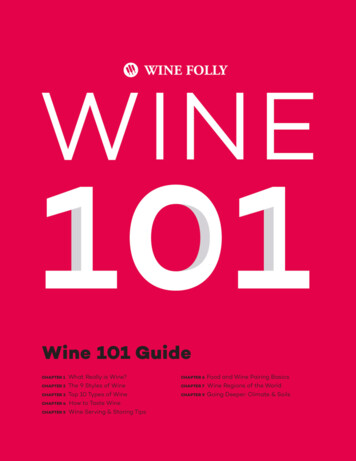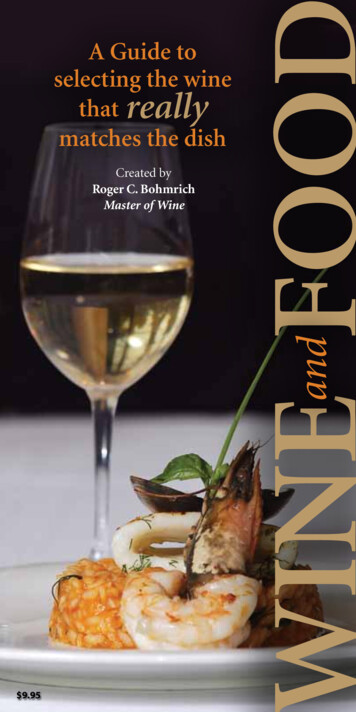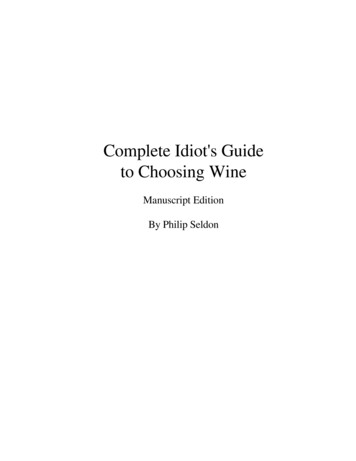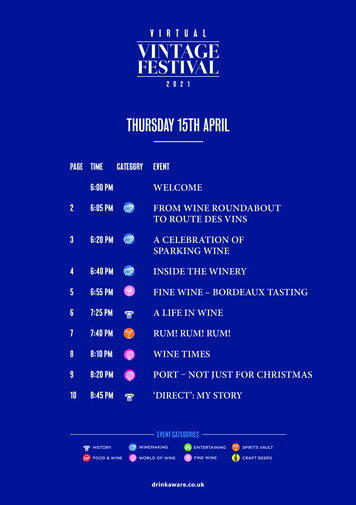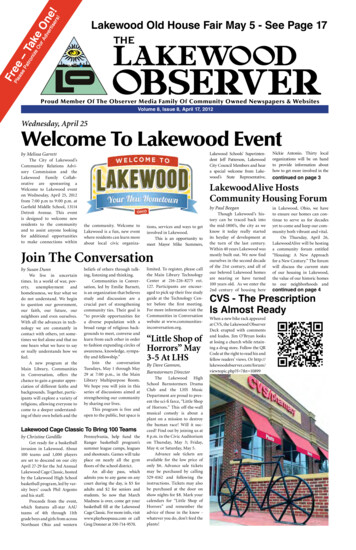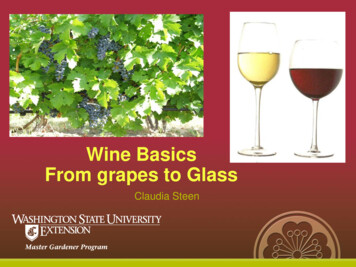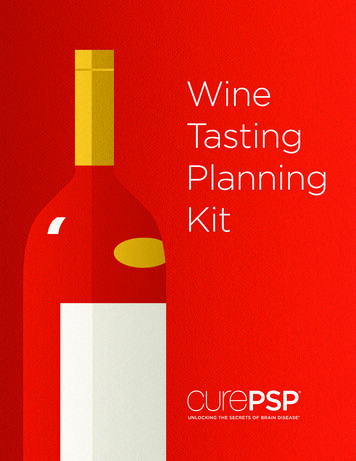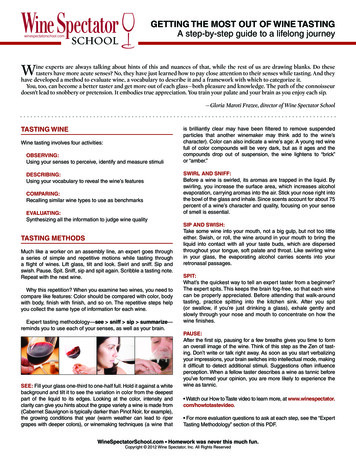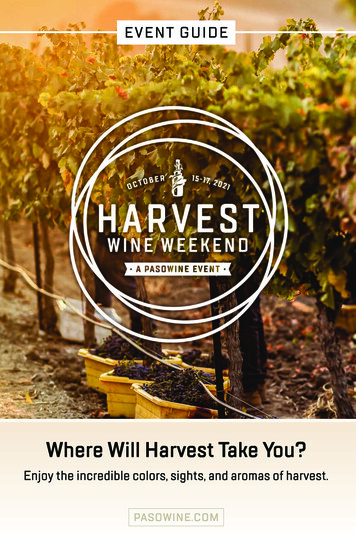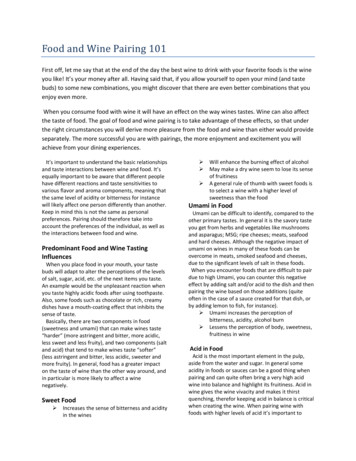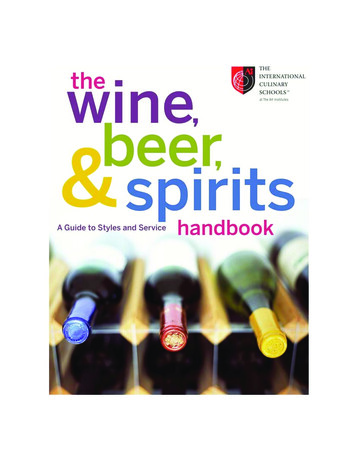
Transcription
ffirs.indd ii3/13/09 12:40:30 PM
thewine,beer,& spiritshandbookffirs.indd i3/13/09 12:40:30 PM
ffirs.indd ii3/13/09 12:40:30 PM
thewine,beer,& spiritshandbookA Guide to Styles and ServiceJoseph LaVilla, Ph.D., CECPhotography by Doug WynnJohn Wiley & Sons, Inc.ffirs.indd iii3/13/09 12:40:30 PM
This book is printed on acid-free paper.Copyright 2010 by Education Management Corporation. All rights reserved.Published by John Wiley & Sons, Inc., Hoboken, New Jersey.Published simultaneously in Canada.No part of this publication may be reproduced, stored in a retrieval system, or transmitted in any form or byany means, electronic, mechanical, photocopying, recording, scanning, or otherwise, except as permitted underSection 107 or 108 of the 1976 United States Copyright Act, without either the prior written permission ofthe Publisher, or authorization through payment of the appropriate per-copy fee to the Copyright ClearanceCenter, Inc., 222 Rosewood Drive, Danvers, MA 01923, 978–750–8400, fax 978–646–8600, or on the webat www.copyright.com. Requests to the Publisher for permission should be addressed to the PermissionsDepartment, John Wiley & Sons, Inc., 111 River Street, Hoboken, NJ 07030, 201–748–6011, fax201–748–6008, or online at http://www.wiley.com/go/permissions.Limit of Liability/Disclaimer of Warranty: While the publisher and author have used their best efforts inpreparing this book, they make no representations or warranties with respect to the accuracy or completenessof the contents of this book and specifically disclaim any implied warranties of merchantability or fitness fora particular purpose. No warranty may be created or extended by sales representatives or written sales materials.The advice and strategies contained herein may not be suitable for your situation.You should consult witha professional where appropriate. Neither the publisher nor author shall be liable for any loss of profit or anyother commercial damages, including but not limited to special, incidental, consequential, or other damages.For general information on our other products and services, or technical support, please contact our CustomerCare Department within the United States at 800–762–2974, outside the United States at 317–572–3993 or fax317–572–4002.Wiley also publishes its books in a variety of electronic formats. Some content that appears in print may not beavailable in electronic books.For more information about Wiley products, visit our Web site at http://www.wiley.com.Library of Congress Cataloging-in-Publication Data:LaVilla, JosephThe wine, beer, and spirits handbook: a guide to styles and service/Joseph LaVilla; photography byDoug Wynn.p. cm.Includes bibliographical references and index.ISBN 978-0-470-13884-7 (cloth)ISBN 978-0-470-52429-9 (custom)1. Wine and wine making. 2. Wine service. 3. Wine—Flavor and odor. 4. Drinking of alcoholicbeverages. I. LaVilla, Joseph. II. Wynn, Doug. III. Title.TP548.N45 2010641.2'2—dc222008042640Printed in the United States of America10ffirs.indd iv9876543213/13/09 12:40:32 PM
ContentsPrefacePART ONE:123456Introduction to WineHow Wine Is Madeftoc.indd v319The Science of Wine TastingWine Storage and ServiceFood and Wine Pairing436183The Health Aspects of Alcohol105Wines from International GrapesChardonnayPinot Noir111113123Cabernet Sauvignon 133Merlot143Sauvignon Blanc149Riesling 157Syrah/Shiraz167Grenache/GarnachaPART THREE:1516171What Makes Wines Taste Different?PART TWO:7891011121314vii175Wines from White GrapesThe Aromatics185Light and Crisp White WinesFat and Full1831972093/13/09 12:41:46 PM
viC O N T E N TSPART FOUR:18192021Light and Fresh231Full and Tannic239Rich and Spicy245Sparkling and Fortified WinesSparkling Wines and How They Are Made253Sparkling and Fortified Wine Service 307Beer, Spirits, and LiqueursBeer319321How Spirits and Liqueurs Are MadeFruit-Based Spirits349Grain-based Spirits359Vegetable-Based SpiritsPART SEVEN:30313233251Fortified Wines 277PART SIX:2526272829217219Soft and JuicyPART FIVE:222324Wines from Black Grapes339371The Role of the SommelierIn the Dining Room379381Wine List Creation and Menu Matching 391Cellar Management and Product ResearchUnderstanding Wine Faults409417AppendicesAppendix A: Maps425Appendix B: Label Terminology433Appendix C: Legislation 447Glossary 465Bibliography 499Indexftoc.indd vi5013/13/09 12:41:50 PM
PrefaceAn important aspect of hospitality education is the study of wine and beverages. Beverages have become an important aspect of the industry, not only in theoverall dining experience, but also for chefs and restaurateurs who wish to enhancethe enjoyment of their food.The recent emphasis on food and wine pairings in printand in menus exemplifies this trend.Two recent trends—emphasizing food, beer andcocktail pairings and the rise of the “bar chef ” using savory ingredients—suggest thetrend is expanding beyond wine.Learning about wine can be an imposing challenge and has some obstacles toeasy learning. First, unlike teaching culinary arts, the frame of reference for the student is often limited. Students cannot begin their actual wine education until theyare twenty-one, yet have eaten all their lives. Discussion of cooking technique andflavors has some familiarity, while wine is often a completely unique experience.Second, wine education is constantly changing. Every year, when a new vintage isreleased, new wines need to be learned. Considering there are thousands of wineries, each producing multiple types of wine, the task can be overwhelming. It’s akinto standing on the 50-yard line at a professional football game and expecting tolearn something about every person in the stands. Finally, the instructional organization brings its own challenges. Much of learning about wine begins in France,after whose traditions most wines are produced. However, studying French wineis simply condensing the wine world into a smaller portion. It is still chock full ofgrapes, styles, techniques, and so on. More advanced classes just delve deeper into thesame material. That makes the initial learning curve steep and subsequent learningrepetitious.AudienceThe need for a new, comprehensive approach is the motivation behind The Wine,Beer, and Spirits Handbook. Most of the wine texts do not address the integration ofwine into the hospitality experience.Wine is treated as an isolated subject, occasionallyviifpref.indd vii3/13/09 12:42:46 PM
viiiP R E FA C Ewith a reference to basic food and wine pairing. Culinary and hospitality studentsand professionals will find this book useful for the emphasis on food and wine pairing as a stand-alone topic as well as comments on how grape varietals and wine stylesinteract with food. For a hospitality student or wine professional, the book focusesnot only on the making and flavor profiles of wine, beer, and spirits, but also on thebusiness of wine service. Basic service needs are discussed, as well as managementtasks such as inventory control, pricing, menu matching, and storage. Functional skillssuch as determination of wine faults and understanding the health and legal implications of wine consumption are also addressed. The Wine, Beer, and Spirits Handbookis perfect for classes in food and beverage management, wine appreciation, spirits, oradvanced restaurant and culinary classes utilizing food and wine pairing.Organization of the TextThe Wine, Beer, and Spirits Handbook approaches the subject from the modernview of varietal labeling and stylistic similarities. Each part can be used as a stand-alonesection to be explored deeply, or the book can be used as a whole to give an overviewof the subject and kept as a reference. The material covers both a breadth of topics aswell as a depth not found in any other single text. Unique to the text is the inclusionof a large section on food and wine pairing, as well as food and beverage interactionsin each part. The Wine, Beer, and Spirits Handbook is also not restricted just to wine,but also includes beer and spirits and their interactions with food.The first part covers the general topic of wine: what makes wines taste different, how they are made, how to taste them, how to store and serve them, how theyinteract with food, and their implication on health.The second part focuses on the important grapes in the market today. Theseare discussed regarding the special circumstances of their growth, wine making,and food interaction. Also discussed are the locations of the best examples of winefrom these grapes. Parts three and four look at secondary or up-and-coming grapes(white grapes in part three and red grapes in part four). These are often singleregion wines, but they are grouped by style similarities.After the discussion on table wines, part five is dedicated to specialty wines,namely sparkling wines and fortified wines. In these sections, production is discussed as well as styles and food interactions. Part six focuses on other alcoholicbeverages, namely beer and spirits. The spirits are divided into fruit-, grain-, andvegetable-based spirits.The modern beverage program is not focused on just winesor just spirits, but encompasses both in a unified offering. The chef or sommeliermust be equally as conscious of beer and spirit choices as they are of wine.fpref.indd viii3/13/09 12:42:47 PM
P R E FA C EixThe final part encompasses the business of being a sommelier. The two sidesto the job are discussed, the service and the managerial. Service discussion includeshow to approach the table and methods of wine sales to customers, while the managerial discussion includes pricing methodology, storage allotment, and productresearch. Included in these chapters are the development of wine lists, matchinglists to menus, and determining faulty wines.Features for StudentsThe Wine, Beer, and Spirits Handbook design offers a simple method of learning wine based on grape varietal rather than on region. The grape informationincludes details on viticulture particular to each varietal and how that influencesflavor.Vinification techniques for each varietal are also included. Each major varietal has a detailed description of its tasting profile, as well as individual descriptions of the classic regions of origin and their distinctions. Food and wine pairingguidelines for each varietal and style class are also included. Each major varietal hasa summary side bar on basic information as well as flavor profile.The appendices contain sections that aid the student in deciphering a winelabel and local legislation. The maps are designed to give students visual referencefor the classic wine regions of the world discussed in the text. Finally, a glossary ofthe wine- and spirit-related terminology used in the text is included.Instructor ResourcesAn Instructor Manual (978–0–470–25407–3) accompanies this text for qualifiededucators. The manual includes lesson plans, presentation slides, and additionalexam questions. Lesson plans, slides, and exam questions are divided by depth ofknowledge. An instructor using the text as an introductory course in wine canuse the basic level lessons and exams. An instructor teaching a more advanced classhas materials that emphasize the depth of knowledge in the text. Lesson plans aredeveloped so that they can be stand-alone lessons. Suggested order of lessons isincluded, but individual lessons can be used in classes that may not be wine focused.All instructor resources are available electronically at www.wiley.com/go/ai.fpref.indd ix3/13/09 12:42:47 PM
fpref.indd x3/13/09 12:42:47 PM
AcknowledgmentsThis text would not have been possible without the help and support of several keyindividuals and groups. I thank Michael Nenes, Dr. Michael Maki, and EDMC forasking me to write the text, as well as The International Culinary Schools at TheArt Institute of Phoenix for supporting me as an author and an instructor.Thanks toChef Walter Leible, CMC, my food stylist, as well as Chef Eric Watson, CCC, CCE,and each of the members of The International Culinary School The Art Institute ofPhoenix faculty. Thanks also to Courtney Schmidt for his assistance to Chef Leibleon the photo shoot. I also thank Kobrand Corporation, Palm Bay Imports, Dr.Ann Noble of University at California—Davis, Spaghetti Western Productions, andLettuce Entertain You Enterprises for contributing pictures and wine lists.Thanks toDoug Wynn and Alicia Martinez for coming up with great photographs, as well as toTracy Ahvmada, Cristina Nevarez, José Rodrigias, and Corey Lamb for participatingin the wine drinking and service photographs at Bomberos Café and Wine Bar inPhoenix. Special thanks to Michael Wray, Metropolitan State College, Denver, andCatherine Rabb, Johnson and Wales University, for their critical review of the text.Thanks also to Julie Kerr, Rachel Livsey, and Richard DeLorenzo at John Wiley &Sons for helping bring this text to reality. We would also like to thank the reviewerswho provided feedback on this text in its various stages of development:Sally Frey, The Art Institute of Pittsburgh, PAEyad Joseph, The Art Institute of California, Inland EmpireJoe Raya, The Art Institute of Charleston, SCAlbert Schmid, Sullivan University, KYKenneth Mertes, Robert Morris College, ILxiflast.indd xi3/13/09 12:44:09 PM
flast.indd xii3/13/09 12:44:09 PM
PARTONEintroductiontoc01.indd 1wine3/13/09 11:52:43 AM
2I N T R O D U CT I O N TO W I N EWhile wine is simply the fermented juice of grapes, it has gaineda place in our psyche as a religious or status symbol. All wine is the same,yet all wines are different. This section expands on the methods of growinggrapes and making wine and why all wines do not taste the same. Otherbasic principles of storage, service, and the interaction of wine with foodare also expanded upon, as well as the recent interest in wine’s benefits forimproving health.Chapter 1 What Makes Wines Taste Different?Chapter 2 How Wine Is MadeChapter 3 The Science of Wine TastingChapter 4 Wine Storage and ServiceChapter 5 Food and Wine PairingChapter 6 The Health Aspects of Alcoholc01.indd 23/13/09 11:52:44 AM
chapter1What MakesWines TasteDifferent?Wine is a unique agricultural product. What other food producthas aisles upon aisles in stores devoted to it, with so many different varietiesand different producers? How can two bottles, labeled with the same grape andfrom the same region, taste so different? How do you tell the difference or try todecipher what is inside the bottle?Many factors cause wines to taste different from one another. The mostobvious and the most important variable is grape variety. Beside grapevariety, grape quality and flavor are affected by the climate, the type ofsoil, and the agricultural practices (called viticulture) used for growing andharvesting grapes. The wine making process also creates distinctions betweenwines. All of these factors influence the quality and flavor of the final wine.Upon completion of this chapter, the student should be able to:Explain the botanical background of grape varietiesDiscuss the life cycle of the vineDescribe when and how to harvest grapesDiscuss the types of climate and their influence on grape growingExplain how topography influences grape growingDiscuss the influence of soil on grape growing3c01.indd 33/13/09 11:52:45 AM
4W H AT M A K E S W I N E S TA S T E D I F F E R E N T ?The GrapeGrape plants are part of the family of vining plants Ampelidaceae (or Vitaceae insome references) in the genus Vitis (grape).Within the genus Vitis are many speciesof grapes that developed around the world, including vinifera, labrusca, rotundafolia, and amurensis, to name a few. While wine can be made from any of thesespecies, Vitis vinifera produces the majority of wine as consumers know it. Withinvinifera there are several thousand subspecies, called varieties or varietals, whichhave individual characteristics. Just as a Granny Smith apple differs from a RedDelicious apple, so it is with grape varietals.Each grape species evolved as woodland vines, climbing trees to reach the sun,and producing tasty, easily pickable fruit that enticed birds to transport the seeds.Depending on the conditions of the area, some vines mutated to better adapt totheir surroundings.These mutations led to the differentiation of the grape varieties.As different varieties cross-pollinated, new varieties were created.Vines also propagated via layering, a process by which a vine coming in contact with the forestfloor would sprout new roots. If the original branch was severed, then a new plant,identical to the first, would have been created.N E W G R A P E VA R I E T I E SModern nurseries use both the sexual and asexual propagation of grapevines tocreate new plants. If a nursery wants to create a new variety, it can sexually propagate new vines by physically controlling the pollination of the grape flowers.Pollinating a vinifera variety with a different vinifera variety produces a cross. Plantscientists often do this to create a new variety that will hopefully have certaindesired characteristics from each parent. The best example of this process can befound in Germany, where many crosses between Rielsing and Sylvaner (referencedas Riesling x Sylvaner) have been created. Because each attempted cross produceda different mix of genes, each cross has different characteristics. In some cases,the cross was successful enough to be recognized as a new varietal, like MullerThurgau or Scheurebe.If a plant scientist breeds vinifera with a different species (such as labrusca) theresult is called a hybrid. Scientists hybridize grapes in an attempt to create a grapethat has the great wine making characteristics of vinifera with the Americangrape plant resistance to phylloxera, mildew, and cold winters. Initial attemptsresulted in poor-quality wines that tasted more like the labrusca than the vinifera(i.e., more like grape juice than wine). Further work has developed hybrids suchas Vidal Blanc and Vignoles, which are commonly used for wine production in theeastern United States and Canada due to their increased cold tolerance.c01.indd 43/13/09 11:52:45 AM
THE GRAPE5G R A P E V A R I AT I O N SWhether it is a naturally occurring varietal, a cross, or a hybrid, variations developwithin the group. Some plants may thrive better in wetter soil, some may like moresun exposure, or some may have a soil preference. A grower can take advantage ofthis by propagating the vines that do the best at that site. This asexual propagation produces plants called clones. The creation of clones is a controlled version oflayering, which grapevines do naturally. Each plant is identical to the parent, so itis just as likely to thrive under the same vineyard conditions. The use of clones isnot restricted to single, original sites, but is used by growers who have similar siteconditions in other areas of the world. Growers looking to plant in new sites cancompare the conditions of their site to those of the clone’s origin. They can thenorder from their nursery the appropriate clone that is adapted to that environment.Not all varietals yield lots of choices. Some grape varieties (such as Pinot Noir)are more sensitive to site selection than others, and therefore yield more clones.If there are multiple clones to choose between, that choice becomes extremelyimportant. A poor clonal selection will result in an inferior wine, while the correctclone can yield a top-quality wine.G R OW T H CYC L EThe growth cycle of the vine is very consistent from year to year. As the springtime temperature reaches about 50ºF (10ºC), the sap begins to rise in the branchesand run through the dormant vine, and new buds begin to swell. These buds willbecome leaves and new canes, or woody stems, from which the fruit will be produced. Grapes are produced only on the new year’s growth on a vine. As the temperature reaches 68ºF (20ºC), inflorescence, or flowering, occurs.The flowers are notbig and showy, but rather small, typical of wind-pollinated or self-pollinated plants.When the flowers get pollinated, they begin to form berries that will become thegrape cluster.A grower is not concerned with the origin of the pollen so long as the pollination is complete. The seeds that develop will not be used to grow new plants,so their parentage is unimportant. If the weather during flowering is not calmand consistent, the vine has the potential to succumb to shatter or millerandage.Shatter, also called coulure in France, is the spontaneous dropping of flowers beforethey have a chance to get pollinated. This will result in a lower yield to the farmer.Millerandage is the incomplete pollination and development of the grape cluster.A cluster suffering from millerandage will have both seeded and seedless grapesdeveloping side by side. These do not ripen at the same time and therefore willdetrimentally affect the juice at harvest.c01.indd 53/13/09 11:52:46 AM
6W H AT M A K E S W I N E S TA S T E D I F F E R E N T ?Grapevine inflorescenceawaiting pollination.Once pollination has occurred and the clusters have begun to form, the plantwill focus on cane and leaf growth. Canes are the woody stems that will hold thedeveloping grape clusters that year.The leaves are the engines producing the sugarsthat will eventually be transferred to the grapes. In midseason, a noticeable shiftoccurs and the ripening process, called veraison, begins. The beginning of colorchange that signals that veraison has begun. During the next four to six weeks, thegrape clusters will change from small, hard green berries to plump, soft, sweet colored fruit. During this time, the sugar produced by the leaves is transferred to thefruit, the amount of acid in the fruit decreases, and the tannins begin to soften.HARVESTHarvest usually occurs four to six weeks after veraison begins, sometimes longerdepending on the varietal. As the grapes approach harvest, several factors are analyzed to determine the optimal picking date. Foremost is sugar content, also knownas physiological ripeness. As the grapes ripen, sugars produced by the leaves are transported to the grapes. Secondly, acid levels are monitored. While unripe, the acidsin the grapes are extremely high, but as ripening progresses the acid level decreases.Acid is important in wine, so a grower is looking to balance the sugar level withthe acid level. Finally, in the case of red wines, is phenolic ripeness. The compoundsthat characterize red wines, tannins, coloring compounds, and some flavor compounds are from a class of chemical substances called phenols. For some wineries, phenolic ripeness is more important than sugar/acid balance for determiningharvest.c01.indd 63/13/09 11:52:46 AM
7THE GRAPEA grower, often in conjunction with a wine maker, will use a variety of methodsto determine the optimal time to harvest the grapes. For many years, the indicatorwas taste. The grower would pick random grapes throughout the vineyard, tastingeach to determine if the correct balance of flavors had been achieved for wine production.This is still the method to best determine phenolic ripeness. More scientificmethods involve the use of pH meters and refractometers. A refractometer is a scaledprism attached to a viewing tube. By squeezing juice onto the prism and lookingthrough the viewer, the grower can see how much sugar is in the juice by how thelight is refracted. Several different scales are used to measure sugar concentration:Brix in the New World, Baumé in France, and Oechsle in Germany.Determining Sugar ConcentrationsDifferent scales are used to determine sugar concentration in grape juice. Allare related to density—either by measuring specific gravity or concentrationof dissolved solids. Below are the three main scales:䊏 Brix:䊏Most commonly used in North America and by scientists䊏Measures sugar concentration in solution by weight䊏 Baumé䊏Used in Europe and Australia䊏Measures percentage of concentration of a solution䊏Yields a direct measure of potential alcohol in juiceºBaumé % alcohol by volume after fermentation12.2 ºBaumé juice can produce 12.2% alcohol䊏 Oechsle䊏Used in Germany䊏Measures specific gravity of a solution䊏Directly related to sugar content of juiceBrix and Baumé may be interconverted using:ºBrix ºBaumé * 1.8c01.indd 73/13/09 11:52:47 AM
8W H AT M A K E S W I N E S TA S T E D I F F E R E N T ?After harvest and when the vines have fallen dormant for the winter, theyare pruned to prepare the new growth for the next season. There are two mainpruning methods, spur pruning and cane pruning. In spur pruning, the canes areremoved and only a bud or two are left on the original trunk to form the fruitingcanes next year. In cane pruning, all but one or two canes are removed, and thesewill bud to form the fruiting canes next year.These methods, combined with multiple types of trellising systems, control the quantity and quality of fruit producedby a vine each year. The method of pruning and training must be made when thevineyard is first planted, and will affect the method of harvest.CONTROLLING GRAPE PRODUCTIONWhy would a grape grower be interested in controlling the amount of grapesproduced? Wouldn’t the vintners want to produce as much as possible, in orderto maximize the money they could make? Yes and no. One more factor comesinto play when growing grapes, and that is the quality of the grapes produced. Inmost cases, quality is inversely proportional to quantity. In other words, the moregrapes a vine produces, the lower in quality those grapes are. One could considerthat a vine has only a set amount of energy, or quality, it can transfer to the grapes.This can be correlated to the amount of sugar the leaves produce via photosynthesis and how it is distributed amongst the grapes. The more grapes that hangon the vine, the more diluted that quality is per grape, the less energy is exertedper bunch to get those grapes ripe, or the less sugar gets placed in each berry. Ifa vine cannot expend enough energy to ripen a bunch, the grapes will possessvegetal flavors and will not develop the typical aromas needed for quality wine.With this in mind, some growers will conduct a “green harvest” around the timeof veraison. A green harvest is the clipping of unripe clusters off a vine in order todecrease the yield and allow the vine to focus its energy on the remaining clusters.It is beneficial to the grower because higher-quality grapes will bring a higherprice at market.While all grapevines undergo the same cycle each year, each varietal will display unique physical characteristics. There are obvious differences like skin color(which can vary from pale green to peachy to bluish to almost black) and grapestructure (skin thickness, amount of pulp, and size of pips all affect the resultantwine). Some varietals may have the potential to ripen with a lot of sugar contentand little acidity, while others may retain high acidity levels. Some lose qualityquickly if overcropped, while others can retain their quality at higher yields. Aseach grape variety is discussed in future chapters, the relationship between vinegrowth, grape characteristics, and wine flavor will be analyzed.c01.indd 83/13/09 11:52:48 AM
C L I M AT E9Phylloxera VastatrixThe discussion so far has assumed that grapevines can be propagated and plantedas any other plant. Unfortunately, in the majority of the wine regions of the world,that is not the case. The reason: a small root louse known as phylloxera vastatrix.Phylloxera is native to the eastern United States and Mississippi River Valley and hasa very complicated life cycle. Phylloxera can live above ground or below ground,and does not have one distinct series of stages needed to reproduce. Because of themultiple life paths phylloxera can follow, insecticides are useless for eliminating aninfestation. The form of phylloxera that destroys vines is a louse that chews on theroots of grapevines.The American vine species that are native to the eastern UnitedStates adapted over the years to form calluses around where phylloxera attackedthe roots. This adaptation allowed the roots to continue transporting nutrientsand water to the vine, and mitigated the damage done by phylloxera.Initial attempts to plant vinifera in the eastern North American colonies resultedin failure. Most of the failures were blamed on mildew and mold, though the nativephylloxera was more likely the culprit. In the middle of the nineteenth century, someAmerican vines were brought to Europe. They carried with them phylloxera as astowaway.The vitis vinifera, native to Europe, had never been exposed to phylloxera,let alone adapted to it. Instead of forming calluses on the roots, the roots becameclogged as the vine tried to block the infestation. Eventually, all the roots would beuseless at transporting nutrients to the vine and would die.Thus began a slow devastation of the vineyards of Europe. Several failed solutions were attempted, includingflooding and spraying. Eventually the carrier was determined to be the cure.Viniferacuttings (called scions) were grafted onto American roots (the rootstock). Thus thevineyards were able to be replanted. Much research in hybridization is focused oneither developing resistance in vinifera stock or developing new rootstocks.Thoughis has taken many years to achieve acceptance, the majority of vineyards around theworld are grafted vines planted on hybrid rootstocks.ClimateAnother key factor affecting how a wine tastes is the climate where the vineyard islocated.The majority of wine growing regions in the world are located in two bandsaround the globe, between 30º and 50º latitudes north and south of the equator. Inthe Northern Hemisphere, this band covers most of Europe (southern Germany toNorth Africa), the United States, southern Canada, northern Mexico, and the MiddleEast, as well as parts of China. In the Southern Hemisphere, every landmass that fallsin the band grows gr
with a reference to basic food and wine pairing. Culinary and hospitality students and professionals will fi nd this book useful for the emphasis on food and wine pair-ing as a stand-alone topic as well as comments on how grape varietals and wine styles interact with food. For a hospitality studen
